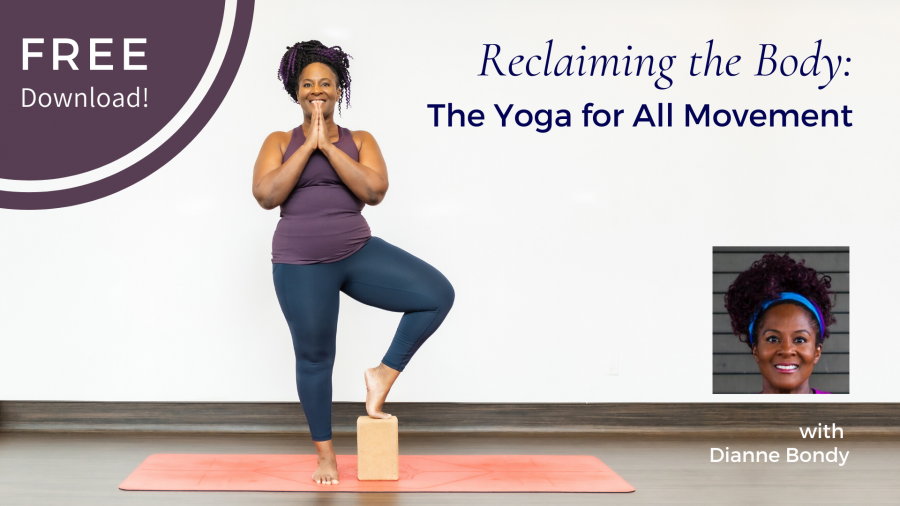Free Download! Reclaiming the Body: The Yoga for All Movement
Course Info
- Price:
- $0.00
Dianne Bondy
 Dianne Bondy is a social justice activist, author, accessible yoga teacher, and the leader of the Yoga For All movement.
Her inclusive approach to yoga empowers anyone to practice—regardless of their shape, size, ethnicity, or level of ability. Dianne is revolutionizing yoga by educating yoga...
Dianne Bondy is a social justice activist, author, accessible yoga teacher, and the leader of the Yoga For All movement.
Her inclusive approach to yoga empowers anyone to practice—regardless of their shape, size, ethnicity, or level of ability. Dianne is revolutionizing yoga by educating yoga... 
Author Dianne Bondy is a social justice activist, Accessible Yoga teacher and a leading figure in the Yoga for All movement. She is one of the leading figures in the movement to revolutionize yoga by educating yoga instructors around the world on how to make classes more welcoming and more safe for all kinds of practitioners.
In this free download, she talks about the growing awareness in the yoga community that yoga has been too white, too skinny, and too exclusive of anyone who doesn't have a standard yoga body.
“When I first got into yoga, I started to see an overrepresentation of able-bodied, white women. In every yoga space I went to, I was often the only black person, the only person of size, the only person of color,” Dianne notes. “Yoga publications did a good job of not featuring bodies of color, not featuring bodies of size, not featuring people from the LGBTQ community or people with nonconforming bodies, plus-sized bodies, and so on. We were seeing a cultural norm of what a European beauty looks like.”
Dianne shares how the Yoga for All movement got started and talks about the emergence of leading voices in the yoga community, who are slowly changing the narrative around what yoga is all about, and reclaiming the practice for people of all shapes, skill levels, and color.
An important part of this development, Dianne notes, has been the growth of social media.
“Social media is a space where we get to create our own narratives; I don't have to wait to be validated by a publication or a company for my work. I can put my work out there and people who it resonates with will find me,” she notes. “At least three or four times a week I get an email saying, ‘I never thought I could do yoga until I saw a picture of you doing yoga, and your body looked like my body.’
“And that's so important because if you don't see people that look like you, then you don't think these things are for you.”
Dianne also talks about the teaching methodology she has developed for teaching effectively to people with diverse bodies.
“The way we frame our language around our bodies is particularly important,” she notes. “In North America, we have been taught through the fitness culture that fit people look a certain way. We continue to perpetuate that through our language and the way we teach. So the way we talk about our bodies is important.”
Dianne also emphasizes the importance of letting go of the idea that everybody has to look exactly the same.
“In today’s yoga culture, you automatically assume that if you can't execute a pose in the most traditional, esoteric way presented, then there must be something wrong with your body,” she notes. “But in reality, we simply need to adjust the pose to fit the body that we're in, and not try to fit everyone into a cookie-cutter idea of what a given pose should look like."
To avoid this, it’s important for yoga teachers to set expectations at the beginning of class, every class all the time, Dianne notes.
“I sit down and say to them, there is no full expression of the pose. I tell everybody that we're a myriad of bodies within this room and everyone’s going to look different. And that’s really important. Even though it's human nature, it's really important for us not to be looking around at everybody around us in a way that we're comparing ourselves.
“When we're looking at the most flexible person in the room with perfect body proportions, we try to execute this picture of the pose and when we can’t, we think that we don't belong there. So it’s important to address that, and set the expectation at the beginning of the class that everybody's going to look different.”
Dianne also emphasizes that the key to good teaching is to use language that invites people to explore and be curious about their body.
“What's really, really important for me is to have people experience the joy of movement in their body and be curious,” she notes.
“Let's be curious about what this feels like. So we're here, and let's be here. And if you're feeling stable and engaged and your breath is smooth, then your body's telling you, this is where I need to be. And if you're feeling like I want more, maybe explore adding a block or bringing your fingers to the floor."
“So I always invite people to explore what comes up for them in a way that's not performative or pushing past what's available to them. So again, it's always about setting expectations and letting people know that there's places to grow. It's called a practice because we come back to it over and over and over again. And every time we come back to it, there's something new to learn.”